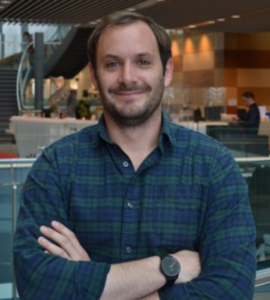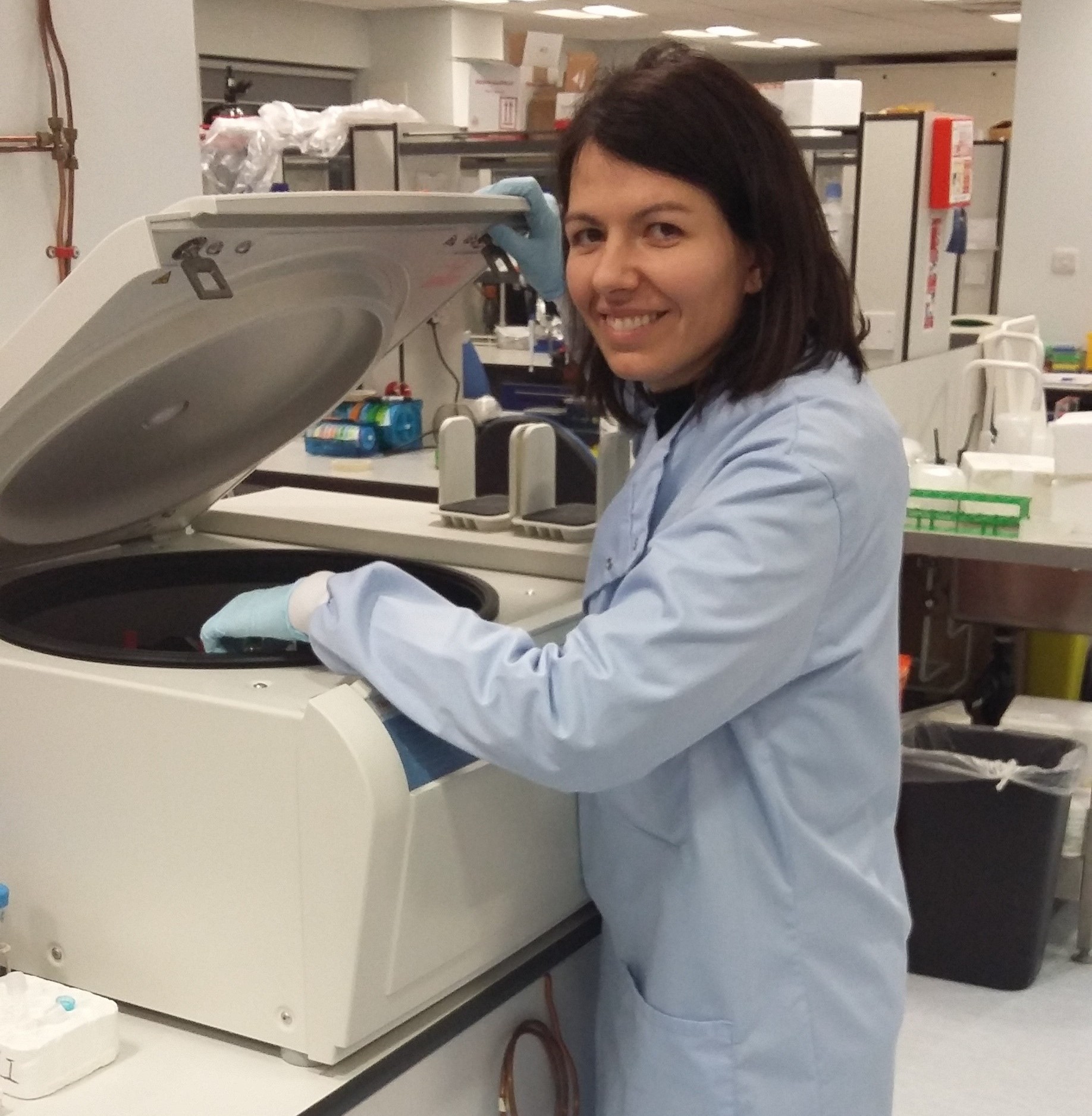
21 Oct 2025
A decade of progress and impact
As we wrap up our John Goldman Fellowship (JGF) anniversary month, we wanted to take a moment to showcase some of the incredible impact these fellowships have had on leukaemia research. The JGFs have been instrumental in supporting pioneering researchers, enabling them to explore bold ideas, develop innovative approaches, and ultimately bring us closer to new treatments for patients.
At a time when the majority of early-career researchers leave academia – with only 30% remaining three years after completing their PhDs (HEPI1) – the JGF is bucking the trend. An impressive 75% of our fellows are still working in academic research five years after their fellowship, driving life-changing discoveries and shaping the future of leukaemia treatment.
The fellowships not only help promising scientists stay in research, but also set them on a trajectory towards leadership. More than 40% of our fellows have gone on to secure major funding from other organisations such as the Medical Research Council, Wellcome, Cancer Research UK and Blood Cancer UK. Together, they’ve brought in nearly £30 million in additional research investment – a powerful demonstration of how the JGFs provide a vital launchpad for breakthroughs.
The JGF scheme have been instrumental in supporting pioneering scientists, enabling them to explore bold ideas, develop innovative approaches and ultimately bring us closer to new treatments for patients. To put this into perspective, developing a successful new drug is a long and complex journey – often taking anywhere from 10 to 20 years before it reaches patients.
Thanks to the vision and dedication of our John Goldman Fellows, we’ve already seen remarkable progress in multiple areas – from uncovering the genetic drivers of leukaemia to identifying new potential treatment routes which could transform patient outcomes. In this blog we’ll highlight some of the breakthroughs which offer real potential for patient benefit in the future.
Lead researcher: Dr Matthew Blunt
Leukaemia sub-type: chronic lymphocytic leukaemia

Dr Matthew Blunt, University of Southampton
Dr Matthew Blunt has a focus on chronic lymphocytic leukaemia (CLL), which is a slow growing type of leukaemia affecting lymphocytes- a type of white blood cell. Since receiving his JGF Dr Blunt and his group have made significant strides in enhancing our understanding of CLL therapies, particularly the repurposing of existing medications. This approach not only accelerates the development process, but also facilitates quicker access to treatments for patients.
One of Dr Blunt’s notable achievements involves the exploration of monalizumab, a monoclonal antibody that targets the NKG2A receptor on immune cells. By inhibiting NKG2A, monalizumab enhances the activity of natural killer (NK) cells and CD8+ T-cells, which are crucial for attacking cancer cells. Currently, monalizumab is undergoing Phase 3 clinical trials for solid tumours, including head and neck cancer, and non-small cell lung cancer (NSCLC). This ongoing clinical development allows for a more rapid translation into CLL trials, potentially expediting its availability for CLL patients.
Dr Blunt is actively collaborating with leading clinicians to help inform future clinical trials that assess the efficacy of monalizumab in combination with other therapies for CLL and lymphoma, aiming to improve patient outcomes.
Another significant area of Dr Blunt’s research involves selinexor, a medication already approved for treating multiple myeloma in the UK and relapsed / refractory diffuse large B-cell lymphoma (DLBCL) in the USA. Dr Blunt’s team discovered that selinexor can activate NK cells against both CLL and lymphoma cells, offering a new mechanism to boost the immune response. This finding is particularly promising as it suggests that selinexor could be used to enhance immunotherapy strategies for various blood cancers.
In collaboration with Karyopharm Therapeutics, the manufacturer of selinexor, Dr Blunt’s group is working to help inform future clinical trials that combine selinexor with other immunotherapies, aiming to improve treatment efficacy for CLL patients.
Lead researcher: Professor Vignir Helgason
Leukaemia sub-type: chronic myeloid leukaemia

Prof. Vignir Helgason, University of Glasgow
Our next highlight takes us not only to another leukaemia sub-type but also to one of our JGFs located in Scotland. Prof Vignir Helgason and his team have made progress in the other major sub-type of chronic leukaemia: chronic myeloid leukaemia (CML). His research has uncovered an innovative way to target leukaemic stem cells by repurposing an existing drug. Lomerizine – normally used to treat migraines – has been identified as a calcium channel blocker that reduces the activity of mitochondria – the cell’s energy producing structures.
Leukaemia stem cells are particularly reliant on mitochondria because they reproduce faster than normal cells, leading to higher calcium metabolism compared to healthy blood cells and CML cells. By targeting this vulnerability, lomerizine can selectively disrupt the energy supply of leukaemic stem cells without harming normal cells.
In preclinical studies, lomerizine showed effects comparable to imatinib, a standard therapy for CML, and when used in combination the results were even more impressive. The team has tested these findings in mouse models and even in patient samples, representing an exciting first step toward potential clinical trials.
Lead researcher: Dr Simon Richardson
Leukaemia sub-type: acute lymphocytic leukaemia

Dr Simon Richardson, University of Cambridge
Continuing along the theme of “repurposing” drugs, another JGF, Dr Simon Richardson, University of Cambridge, is making strides in the field of B-cell acute lymphoblastic leukaemia (B-ALL), which is the most common cancer in children. Along with his colleague Dr Brian Huntly (who was also funded by Leukaemia UK in 2024), Dr Richardson has identified a potentially safer, more targeted way to treat this disease.
Their recent study explored a combination of two oral drugs: venetoclax, already used in the treatment of acute myeloid leukaemia (AML); and a new class of drugs that target a protein called CREBBP. Together these drugs work in synergy to trigger a type of cell death called ferroptosis in the B-ALL leukaemia cells, while sparing healthy ones – offering a completely new way to target this disease. This dual-action approach could offer a less toxic, fully oral therapy, making treatment more accessible and easier for patients.
The team is actively seeking funding to progress to clinical trials. Due to regulatory requirements and the setup needed at hospital sites, the first patients are expected to receive this treatment in 2027. The trial is predicted to recruit over 2.5 years, initially in adults, with the potential to expand to teenagers once safety is confirmed.
Dr Richardson’s work is supported by Rosetrees.
Lead researcher: Dr William Grey
Leukaemia sub-type: acute myeloid leukaemia

Dr William Grey, University of York
Acute myeloid leukaemia (AML) is known as one of the most aggressive and difficult to treat forms with a 5-year survival of 22%. One of our Fellows, Dr William Grey , University of York, and his group have made exciting progress in understanding how blood stem cells and leukaemia stem cells behave. Their research has shown that blocking a protein called CKS1 can selectively eliminate the stem cells that drive AML. Simultaneously this has been found to protect – or even boost – healthy blood stem cells. This is particularly unusual, as most cancer treatments damage both healthy and cancerous stem cells.
The group has also mapped the signalling pathways behind CKS1’s effects, demonstrating that careful dosing could either target leukaemia cells or support healthy blood recovery after treatment. These discoveries make a strong foundation for CKS1 inhibition as a potential new therapy, with ongoing support from the Medical Research Council Discovery Medicine North programme exploring how to make new drugs which could be eligible for clinical trials.
Lead researcher: Dr Konstantinos Tzelepis
Leukaemia sub-type: acute myeloid leukaemia

Dr Konstantinos Tzelepis, University of Cambridge
As AML has one of the worst survival rates it is encouraging that more than one of our JGFs is making strides in the field. Dr Konstantinos Tzelepis, University of Cambridge, has made significant progress in identifying novel therapeutic areas for this tricky sub-type. His group’s recent collaborative work with the Flynn Lab and Boston Children’s Hospital in the USA has led to the discovery of a protein called csNPM1 (cell surface nucleophosmin 1) on the surface of leukaemic stem cells – a finding that challenged previous beliefs where NPM1 was thought to reside only inside cells.
This discovery is pivotal because csNPM1 is present on leukaemic stem cells, which are responsible for the initiation and recurrence of AML. Targeting these cells is crucial for effective treatment. The team has also developed a therapeutic agent which targets csNPM1, which has shown promising results in mouse models and is now being tested in patient-derived samples. This progression brings the potential for clinical trials closer to reality.
In parallel, Dr Tzelepis’s group has been investigating another protein, METTL3, which plays a role in RNA modification and is implicated in AML. They have developed a METTL3 inhibitor that has showed promising results in early studies. This work has led to a collaboration with STORM Therapeutics, a clinical stage biopharmaceutical company, to further develop and test this inhibitor in clinical settings, initially focusing on solid tumours with plans to extend to haematological cancers like AML.
This is just a whistle-stop tour of these projects and the potential impact they, along with other work from our JGFs, can achieve. While the focus here is on the difference this research makes for patients, it’s equally important to recognise the impact on the careers of our Fellows. During this time, many have gone on to establish new groups, diversify their research, and build valuable collaborations. None of this would be possible without the generous support of our donors, whose contributions make this progress a reality.
We’re pleased to have funded 46 JGFs and will continue to share the difference they are making to stop leukaemia devastating lives.
Discover our research blogs.
Related posts
1 August 2022
New research could help detect leukaemia earlier in older people
New research findings, published in the scientific journal Nature Medicine, could help better predict risk of leukaemia in older people and ultimately improve early diagnosis of the disease. The research…
1 August 2022
Who’s Cooking Dinner? to return on Monday 19th September
Who’s Cooking Dinner reveal all star Chef Line Up Famed Charity event to return on Monday 19th September For the past 24 years, Leukaemia UK, the leukaemia research charity dedicated…
27 August 2020
Leukaemia UK appoints new CEO
The trustees of Leukaemia UK are delighted to announce that they have appointed Fiona Hazell as CEO of Leukaemia UK. Fiona brings a strong track record in not-for-profit leadership, starting her role on 9th September 2020.
4 April 2023
£200 grants for people affected by leukaemia once again available
Leukaemia UK and Leukaemia Care have this month relaunched the ‘Cost of Living Fund’, providing financial grants of £200 to patients with leukaemia, myelodysplastic syndrome (MDS) or myeloproliferative neoplasms (MPNs),…
